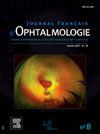Validation of iCare IC200® rebound tonometry for intraocular pressure measurement
IF 1.1
4区 医学
Q3 OPHTHALMOLOGY
引用次数: 0
Abstract
Purpose
To validate the measurement of intraocular pressure (IOP) using rebound tonometry (RT) compared to Goldmann applanation tonometry (GAT).
Methods
We measured air puff tonometry (AT) with estimation of pachymetry, then IOP using GAT and RT in adult patients. We measured internal validity (agreement with Lin concordance coefficient–LCC, sensitivity and specificity for ocular hypertension (IOP threshold > 21 mmHg) and external validity (depending on pachymetry and body mass index) and determined the most comfortable method for the patients.
Results
We included 341 eyes of 171 patients (73.2 ± 10.7 years old, 52.1% men). Mean IOP was 16.5 ± 4.7 mmHg for RT and 16.2 ± 4.1 mmHg for GAT. Mean IOP difference between RT and GAT was 0.31 ± 1.43 mmHg; LCC was 0.95 (0.94 to 0.96, P = 0.005). The prevalence of eyes with an IOP measurement > 21 mmHg was 15.5% for RT and 12.6% for GAT. Sensitivity and specificity of RT were 86% (71.1% to 94.7%) and 94.6% (91.4% to 96.9%) respectively. Depending on pachymetry, LCC was 0.98 (0.98 to 0.99), 0.94 (0.91 to 0.97), 0.94 (0.92 to 0.96), and 0.88 (0.83 to 0.93) between RT and GAT, respectively for the 4 pachymetry groups (< 500, 500–520, 520–560, > 560 μm). Results were similar across BMI ranges (< 25, 25–30, 30–35, > 35). The most comfortable method was RT for 87% of patients.
Conclusion
RT is highly reliable in adult IOP measurement and independent of pachymetry and BMI.
Objectif
Valider la mesure de la pression intra-oculaire (PIO) à l’aide de la tonométrie à rebond (RT), par rapport à la tonométrie à aplanation de Goldmann (GAT).
Méthodes
Nous avons mesuré la tonométrie à air (AT) avec estimation de la pachymétrie, puis la PIO en utilisant la GAT et la RT chez des patients adultes. Nous avons mesuré la validité interne (Coefficient de concordance de Lin–LCC, sensibilité et spécificité pour l’hypertonie oculaire (seuil de PIO > 21 mmHg) et la validité externe (en fonction de la pachymétrie et de l’indice de masse corporelle), et la méthode la plus confortable.
Résultats
Nous avons inclus 341 yeux provenant de 171 patients (73,2 ± 10,7 ans, 52,1 % d’hommes). La PIO moyenne était de 16,5 ± 4,7 mmHg pour la RT, de 16,2 ± 4,1 mmHg pour la GAT. La différence moyenne de PIO entre RT et GAT était de 0,31 ± 1,43 mmHg, la LCC était de 0,95 (0,94 à 0,96, p = 0,005). La prévalence des yeux avec une PIO > 21 mmHg était de 15,5 % pour la RT et de 12,6 % pour la GAT. La sensibilité et la spécificité de la RT étaient respectivement de 86 % (71,1 % à 94,7 %) et 94,6 % (91,4 % à 96,9 %). Selon la pachymétrie, le LCC était de 0,98 (0,98 à 0,99), 0,94 (0,91 à 0,97), 0,94 (0,92 à 0,96) et 0,88 (0,83 à 0,93) entre RT et GAT, respectivement pour les 4 groupes de pachymétrie (< 500, 500–520, 520–560, > 560 μm). Les résultats étaient similaires selon l’IMC (< 25, 25–30, 30–35, > 35). La méthode la plus confortable était la RT pour 87 % des patients.
Conclusion
La RT est très fiable dans la mesure de la PIO chez l’adulte, indépendamment de la pachymétrie et de l’IMC.
iCare IC200®回弹式眼压计用于眼压测量的验证
目的验证反跳眼压计(RT)与Goldmann压平眼压计(GAT)测量眼压的有效性。方法对成人患者进行气肿眼压测量(AT)和眼压测量(GAT和RT)。我们测量了内部效度(与Lin一致性系数- lcc的一致性)、高眼压的敏感性和特异性(IOP阈值>;21 mmHg)和外部效度(取决于测厚仪和体重指数),并确定最适合患者的方法。结果171例患者341只眼(73.2±10.7岁,男性占52.1%)。RT组平均眼压为16.5±4.7 mmHg, GAT组平均眼压为16.2±4.1 mmHg。RT组与GAT组的平均眼压差为0.31±1.43 mmHg;LCC为0.95 (0.94 ~ 0.96,P = 0.005)。IOP测量眼的患病率>;RT组为15.5%,GAT组为12.6%。RT的敏感性为86%(71.1% ~ 94.7%),特异性为94.6%(91.4% ~ 96.9%)。根据厚度测量的不同,RT组和GAT组的LCC分别为0.98(0.98 ~ 0.99)、0.94(0.91 ~ 0.97)、0.94(0.92 ~ 0.96)和0.88(0.83 ~ 0.93)。500、500 - 520,520 - 560,>;560μm)。BMI范围内的结果相似(<;25、25 - 30、30-35,>;35)。87%的患者最舒适的方法是放疗。结论rt测量成人IOP具有较高的可靠性,且独立于眼压测量和BMI。目的验证眼内减压法(PIO)、眼内减压法(RT)、眼内减压法(GAT)的有效性。成年患者与成年患者相比,成年患者与成年患者相比,成年患者与成年患者相比,成年患者与成年患者相比,成年患者与成年患者相比,成年患者与成年患者相比,成年患者与成年患者相比,成年患者与成年患者相比,成年患者与成年患者相比。lcc的一致性系数(Coefficient de concorconcorde de Lin-LCC)、灵敏度(sensitivity)和灵敏度(spcicicicicidpour l 'hypertonie oculaire (seuil de PIO >);21毫米汞柱)和其他有效的外部(en功能de la pachymacritrie和de l ' index de mass corporelle),和其他有效的外部(la machymacritrie)。研究共纳入341例病例171例(73,2±10,7例,52,1 %)。La PIO moyenne的忧郁指数为16.5±4.7 mmHg, La RT的忧郁指数为16.2±4.1 mmHg。La difference moyenne de PIO entre RT et GAT和La LCC分别为0.31±1.43 mmHg和0.95(0.94±0.96,p = 0.005)。La prassuvalence des yeux avec /;21毫米汞柱,15.5%,倒拉拉RT, 12.6%,倒拉拉GAT。La sensibilit和La spspcicici和La RT 分别为86.6%(71.1%(94.7%)和94.6%(91.4%(96.9%))。Selon la pachymsamtrie, le LCC samtait de 0,98 (0,98 0,99), 0,94 (0,91 0,97), 0,94 (0,92 0,96)和0,88 (0,83 0,93)分别进入RT和GAT 4组pachymsamtrie (<;500、500 - 520,520 - 560,>;560μm)。Les - resimsults和其他类似的组织(<;25、25 - 30、30-35,>;35)。拉西拉西加舒适拉西拉西法治疗87%的患者。结论:rrt检测可检测成人胸腺炎、成年胸腺炎、成年胸腺炎和成年胸腺炎。
本文章由计算机程序翻译,如有差异,请以英文原文为准。
求助全文
约1分钟内获得全文
求助全文
来源期刊
CiteScore
1.10
自引率
8.30%
发文量
317
审稿时长
49 days
期刊介绍:
The Journal français d''ophtalmologie, official publication of the French Society of Ophthalmology, serves the French Speaking Community by publishing excellent research articles, communications of the French Society of Ophthalmology, in-depth reviews, position papers, letters received by the editor and a rich image bank in each issue. The scientific quality is guaranteed through unbiased peer-review, and the journal is member of the Committee of Publication Ethics (COPE). The editors strongly discourage editorial misconduct and in particular if duplicative text from published sources is identified without proper citation, the submission will not be considered for peer review and returned to the authors or immediately rejected.

 求助内容:
求助内容: 应助结果提醒方式:
应助结果提醒方式:


